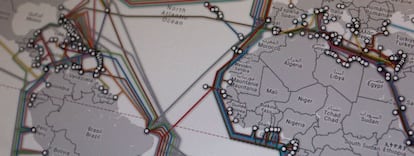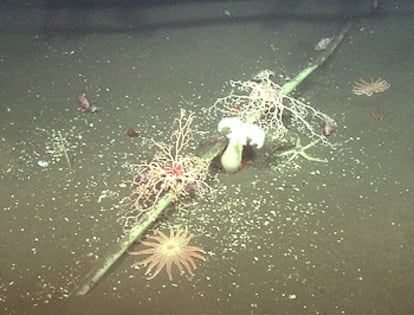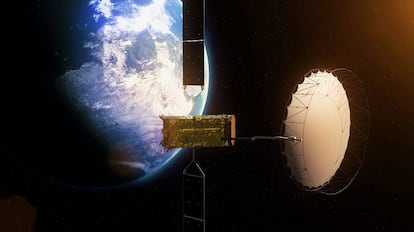Annual global data traffic equals 43 billion HD movies. How does it all flow?
2,000 satellites and enough submarine cables to circle the Earth 30 times make up the essential worldwide communications network

The total amount of data created, captured, copied and consumed worldwide will reach 120,000 exabytes (EB) this year and 180,000 EB in two years, according to Statista. One exabyte equals 20 times the content of all the books ever written as of 2010, according to Acens, a Spain-based Telefónica Tech company. DE-CIX, the world’s leading internet exchange operator, compares this data volume to a 3,700-mile tall tower of DVDs. If that didn’t convince you, think about this: the total global data traffic this year will equal 43 trillion high-definition movies (at three gigabytes each) streaming online. How do you move so much data? A key element is the network of fiber optic highways, especially the submarine cables that measure 745,000 miles end to end, enough to circle the planet 30 times, according to the Norwegian University of Science and Technology (NTNU). Scientists believe this network could be leveraged for other purposes and technology companies are busy developing additional data channels in outer space.
Global data has definitely not peaked and will increase even more as artificial intelligence applications proliferate. “More and more data is being transmitted over the internet because modern digital applications and services require so much information from different sources. This trend will continue as consumer use of digital applications continues to grow,” says Christoph Dietzel, Global Head of Products & Research at DE-CIX.
How does all that data flow? Mostly out of sight, under the sea and in space. The submarine network of about 500 individual cables is 165 years old. The first transoceanic connection in 1858 was operational for only a few weeks and enabled Queen Victoria of England to send birthday greetings to U.S. President James Buchanan. The network has grown steadily ever since, although most of its expansion took place over the last 20 years. The world’s longest fiber optic cable (28,000 miles) serves three billion people in Africa, Europe and Asia and extended to Barcelona last October. The one linking Japan and Europe is 1,400 miles long, while the cable between the United Kingdom and Ireland only measures 75 miles.

Submarine cables
Submarine cables are typically about the diameter of an average human arm. They enclose hair-thin optical fibers coated with polyethylene, copper and water-resistant aluminum. Since this coating can’t protect against damage from anchor drops, nets, underwater topographical features, aquatic fauna and other natural phenomena, its useful life is around 25 years. All the hazards require continuous maintenance by crews aboard strategically located ships who use robots to lift damaged cables from the depths for repair.
The deployment of submarine cables is not completely innocuous, although new technology seeks to minimize harmful impacts. Installation and maintenance can damage or disturb marine habitats by stirring up sediment and redistributing nutrients, especially if dredging and trenching are used. Noise can also affect wildlife.
DE-CIX regional director Theresa Bobis stresses the positive aspects of underwater cables. “If installed correctly, fiber optic cables have a neutral impact on the environment. A study conducted by the University of Southampton (UK) showed that cables are colonized by marine organisms in one or two months, depending on conditions. In fact, cable reels have been positioned off the coasts of Maryland and New Jersey (USA) as artificial reefs to attract marine organisms. These areas can become sanctuaries and increase biodiversity.”

Satellites
Outer space is another channel for all the data transfer our digital society depends on. There are 5,465 satellites (almost half are for telecommunications) orbiting the Earth, according to the UCS Satellite Database. A European Commission report says that although fiber cable offers superior performance in terms of more capacity and speed, it requires more time and resources to deploy. Satellites operate almost immediately after launch and are essential links in areas without broadband access, and for mobile devices and vehicles.
“Both are essential components of the internet infrastructure and respond to different use cases, since everything revolves around speed and bandwidth,” says Bobis. “For now, the main advantage of submarine cables over satellite connections is that they have significantly lower latencies and the capacity to transmit much larger amounts of data.” A one-exabyte transfer rate over cable would enable the download of the entire Netflix video library in 0.25 seconds, or all the content on the internet in 12 minutes, according to DE-CIX.
“We also have innovations such as LEO [low Earth orbit] satellites that can be quickly deployed and are remarkably inexpensive to use,” says Bobis. “Their proximity to Earth also enables higher internet speeds and lower latency. They offer an ideal opportunity for network expansion and to provide coverage in rural areas while fiber-optic infrastructure deployment is underway.”
“Fiber is generally far superior to satellite alternatives in terms of speed and latency,” adds Bobis, “and the internet-related satellite infrastructure on the ground still depends on fiber. Satellites cannot completely replace the fiber-optic network soon, but satellite operators are probably not even aiming for that. It’s becoming increasingly clear that the greatest added value is created when both technologies coexist in meaningful symbiosis and can leverage each other. It will be a long time before we have sufficient network coverage to provide everyone with fiber-optic internet. In the meantime, satellites can be a low-cost supplement.” Bobis notes satellite internet connectivity could be a great asset for rural businesses until the fiber optic network extends into those areas.
An alternative to satellites are high-altitude balloons. The European Commission and six national defense ministries have allocated €63.5 million ($70 million) to the EuroHAPS (High-Altitude Platform Systems) project to build environmentally friendly, recoverable airships. These high-altitude balloons will improve communication capabilities and be used in intelligence, surveillance and reconnaissance (ISR) missions. Space is also emerging as an alternative location for data centers.

Other uses
The world’s communications networks are complementary, says Bobis, and have applications beyond data transmission. “Submarine communications cables could collect data about the deep-sea environment,” says Bruce Howe, of the Department of Ocean Engineering at the University of Hawaii and chair of UNESCO’s SMART Cables initiative.
Brad Lipovsky of the University of Washington (USA) says underground fiber-optic networks also have other uses, such as recording tiny ground vibrations wherever the cable touches the earth. “Fiber-optic sensing is the biggest advance in earth geophysics since the field went digital in the 1970s,” he says.
A study published in Science Report shows the usefulness of transoceanic cables for seismic and water wave sensing. The same journal published a study on how ocean dynamics and seafloor faults can be monitored using distributed acoustic sensing (DAS) with fiber-optic cables.
Sign up for our weekly newsletter to get more English-language news coverage from EL PAÍS USA Edition
Tu suscripción se está usando en otro dispositivo
¿Quieres añadir otro usuario a tu suscripción?
Si continúas leyendo en este dispositivo, no se podrá leer en el otro.
FlechaTu suscripción se está usando en otro dispositivo y solo puedes acceder a EL PAÍS desde un dispositivo a la vez.
Si quieres compartir tu cuenta, cambia tu suscripción a la modalidad Premium, así podrás añadir otro usuario. Cada uno accederá con su propia cuenta de email, lo que os permitirá personalizar vuestra experiencia en EL PAÍS.
¿Tienes una suscripción de empresa? Accede aquí para contratar más cuentas.
En el caso de no saber quién está usando tu cuenta, te recomendamos cambiar tu contraseña aquí.
Si decides continuar compartiendo tu cuenta, este mensaje se mostrará en tu dispositivo y en el de la otra persona que está usando tu cuenta de forma indefinida, afectando a tu experiencia de lectura. Puedes consultar aquí los términos y condiciones de la suscripción digital.
More information
Últimas noticias
Most viewed
- Pablo Escobar’s hippos: A serious environmental problem, 40 years on
- Reinhard Genzel, Nobel laureate in physics: ‘One-minute videos will never give you the truth’
- Why we lost the habit of sleeping in two segments and how that changed our sense of time
- Charles Dubouloz, mountaineering star, retires at 36 with a farewell tour inspired by Walter Bonatti
- The Florida Keys tourist paradise is besieged by immigration agents: ‘We’ve never seen anything like this’










































